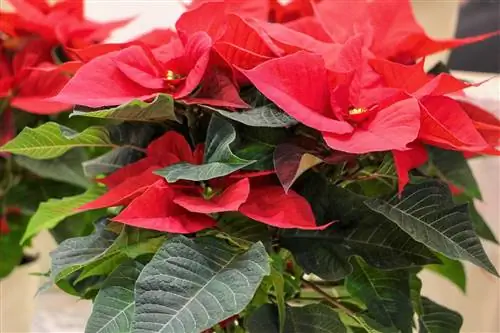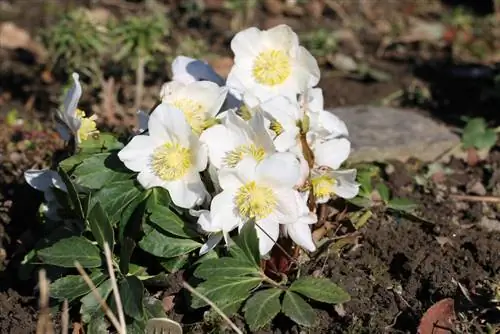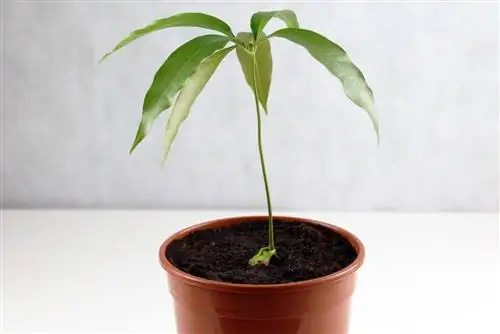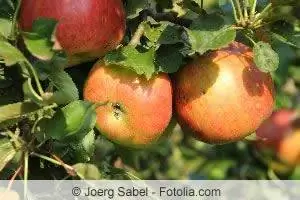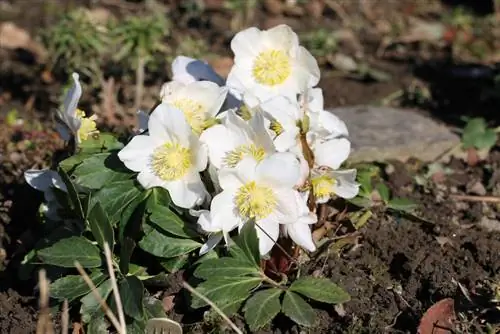- Author admin [email protected].
- Public 2023-12-17 03:39.
- Last modified 2025-06-01 06:48.
Who doesn't get stylish Christmas feelings when looking at a red or white poinsettia? The popular plant, which has decorative star-shaped leaves, is increasingly being cultivated as a classic Advent flower and is enjoying growing popularity. But how is the plant best cultivated so that the full flowers bloom at the right time?
Location and substrate
The Advent star originally comes from warm areas in South and Central America; Even in our latitudes, the plant does not tolerate cold or drafts. The following conditions are required for the ideal location:
- sufficient heat
- lots of brightness
- Temperatures between 15 and 22 °C
- lots of sun
Even if the Christmas star prefers warm and sunny areas within the home, the plant should always be protected from the influence of direct sunlight. It is also important to protect the plant from drafts. For this reason, a frequently ventilated windowsill, for example, is not a suitable location. However, if the window is not opened that often, the windowsill can also be used; then you should make sure that the bench is on the south side of the apartment and not directly above the heating. It is also important to limit some of the direct sunlight; To do this, you can shade the window with a semi-translucent curtain. If it is a wide windowsill, a strongly leafy houseplant can be placed between the poinsettia and the window to provide the necessary shading. In winter, the following points should be considered regarding solar radiation:
- Sun during the morning and evening hours does no harm
- However, the overall lighting must be limited to form the flowers
- an exposure time of 12 hours must not be exceeded
So that the poinsettia can develop well, you should pay attention to a high-quality substrate. Permeable and humus-rich soil is best suited for cultivation.
Watering and fertilizing
Caring for the Advent star includes, above all, correct watering behavior. To ensure a constant water supply, it is important to water the plant regularly; the Christmas star should never dry out completely. However, the correct amount of watering requires some sensitivity; too much moisture easily leads to waterlogging, which is harmful to the plant.
Tip:
It's best to only water the poinsettia again when the soil is almost dry.
If too much has been watered, the plant will react with yellow leaves and general leaf drop. Then you should definitely reduce the amount of water you pour again! Otherwise, the Christmas star can also develop symptoms of root rot. If root rot has already developed, irrigation must be stopped immediately; Only when the substrate has completely dried can you start carefully watering the poinsettia again. In many cases the Advent star can still be saved.
In order to avoid standing water and thus the development of root rot, you should always remove excess liquid from the saucer regularly. It is particularly effective to use a pot that has drainage made of pottery shards or pebbles. In addition to the correct amount of watering, the ideal temperature of the water used also plays a role. Since the Advent star generally cannot tolerate cold, you should always choose lukewarm, soft water for watering. Caring for the Christmas star also includes a targeted supply of nutrients. While an already flowering specimen does not need any additional fertilizer, the plant should otherwise be supplied with nutrients very moderately in winter; A fertilizer application every two weeks is sufficient.
Make the Advent star bloom
To get the poinsettia to bloom, you need short days. Plants from the previous year must be tricked out in this regard so that they can develop their full splendor in time for Christmas. For this purpose, the experienced hobby gardener simulates favorable conditions: little light and short days. To do this, place the plant in a dark room for twelve hours over a total period of six weeks; In this way you encourage them to bloom prematurely. But be careful: light from outside, for example from a street lamp, can also affect flowering!
Note:
Alternatively, it has proven useful to put a bucket or cardboard box over the plants.
Oversummer
The Christmas star is used around Christmas time; If you want to keep the plant for several years, you have to take care of optimal summer storage. To ensure that the plant survives the warm season well, you should consider the following aspects:
- Cutting all flowers and colored bracts in March
- Cut the plant back to about a third
- Storage the crop in a bright and warm location
- The open area is also suitable as a location for the summer
- Fertilization is required once a week
Tip:
If you want to cultivate your Advent star outdoors, you should first put the plant in the shade for a week. This way it can gradually get used to the sun.
During the summer, the poinsettia needs to be watered regularly; For this purpose, the plant is supplied with plenty of water; Only when the top layer of soil has dried should you water again. In this way, the natural living conditions of the plant are simulated, because in Central and South America the climate is characterized by dry phases and alternating heavy downpours. Last but not least, the oversummer can also be used to multiply the Christmas star. For this purpose, head cuttings are taken from the plant in July or August.
Diseases and pests
The Christmas star can be attacked by various diseases and pests; Air that is too dry can be a problem. If these unfavorable conditions exist, the plant will quickly be attacked by scale insects or mealybugs. As an antidote, a soap and spirit solution has proven to be effective, which is applied to the affected parts of the plant using a brush. Alternatively, you can also work with plant protection suppositories, which are simply stuck into the soil.
When the poinsettia is attacked by diseases, care errors are almost always the cause. For example, suddenly falling leaves are a clear sign of poor water management; Either an excess of moisture or a lack of water can be responsible for the symptoms. In addition, a sudden change in temperature can also cause the leaves to fall off. However, if the hobby gardener observes that no colored bracts or flowers are formed, the cause is almost always a lack of darkening.
Poisonousness of Advent stars
Anyone who cultivates a Christmas star should know: the plant is poisonous. Caution is advised, especially if dogs or cats live in the house; The four-legged friends might feel tempted to nibble on the decorative plant.- Muscle cramps, salivation, tremors and vomiting as well as diarrhea and kidney failure can result. If the hobby gardener observes such symptoms on his pet, he should contact a veterinarian immediately; There is approximately two hours left in which an antidote can be administered and the animal saved.
Conclusion of the editors
Those who cultivate a Christmas star create a very special Christmas flair during Advent. The plant can easily be kept by laypeople. If you always realize that it is a fundamentally poisonous plant and take appropriate safety precautions, you will have a lot of fun with the poinsettia.
What you should know about the Advent star in brief
Care
- The red bracts of the Advent star are particularly beautiful.
- However, they are shed after a few weeks that the plant has spent indoors.
- Then the Advent star should get the rest it needs and hardly be watered anymore.
- First, however, the entire plant is shortened by about half.
- In spring the Advent star is then repotted in new potting soil.
- As soon as the temperatures allow it, it can be placed outside.
- A semi-shaded place on the terrace is best suited for spending time outdoors.
- There it is watered moderately and supplied with sufficient nutrients using a conventional flower fertilizer.
- During the first few weeks after repotting, fertilizing is not necessary because the new substrate contains enough nutrients.
- The plant is then brought back into the house in time before the first night frosts.
Flowering time
- The Advent star is a perennial plant that can reach an impressive size over the years.
- In warm areas it even grows several meters high.
- Therefore, it is worth not just throwing it away after flowering, but rather continuing to cultivate it in a bucket.
- The Advent star is one of the short-day plants. Its flowering is favored by special conditions.
- It requires long nights in which it is dark for at least twelve hours for a certain period of time.
- If this condition is not present naturally, it must be created artificially.
- To do this, the plant can be placed in a dark room in the evening, into which no more light should fall.
- Therefore, only a room that is no longer accessible during the night is actually suitable for this.
- It is a little easier to create the necessary darkness with a cardboard box that is placed over the plant in the evening and removed again in the morning.
- To ensure that the poinsettia blooms in time for the season, this procedure should be started between the end of September and the beginning of October.
- At the same time, fertilization is stopped at this time.

